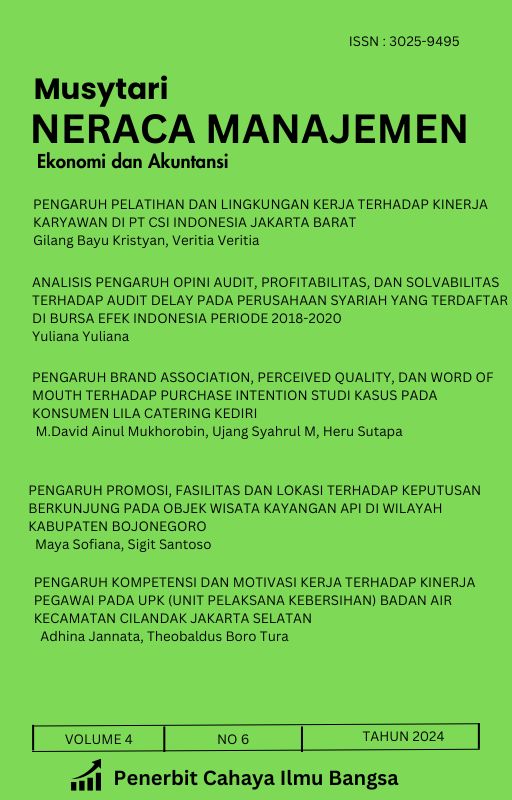WEBSITE SEBAGAI MEDIA PEMASARAN PRODUK-PRODUK UNGGULAN UMKM
Main Article Content
Abstract
Websites as marketing media for superior products of UMKM (Micro, Small and Medium Enterprises) have become an important strategy in increasing competitiveness in the digital era. In this context, websites not only function as virtual storefronts, but also as interactive platforms that enable MSMEs to reach wider consumers. This research aims to analyze the role of websites in promoting superior UMKM products, as well as their impact on sales and brand awareness. Through qualitative and quantitative approaches, the research results show that effective use of websites can increase product visibility, expand distribution networks, and speed up transactions. In addition, a well-designed and responsive website can provide a positive user experience, thereby encouraging customer loyalty. In conclusion, websites are an essential strategic tool for UMKM in facing increasingly fierce market competition, as well as contributing to local economic growth.
Website sebagai media pemasaran produk-produk unggulan UMKM (Usaha Mikro, Kecil, dan Menengah) telah menjadi salah satu strategi penting dalam meningkatkan daya saing di era digital. Dalam konteks ini, website tidak hanya berfungsi sebagai etalase virtual, tetapi juga sebagai platform interaktif yang memungkinkan UMKM untuk menjangkau konsumen lebih luas. Penelitian ini bertujuan untuk menganalisis peran website dalam mempromosikan produk-produk unggulan UMKM, serta dampaknya terhadap penjualan dan kesadaran merek. Melalui pendekatan kualitatif dan kuantitatif, hasil penelitian menunjukkan bahwa penggunaan website secara efektif dapat meningkatkan visibilitas produk, memperluas jaringan distribusi, dan mempercepat transaksi. Selain itu, website yang dirancang dengan baik dan responsif mampu memberikan pengalaman pengguna yang positif, sehingga mendorong loyalitas pelanggan. Kesimpulannya, website merupakan alat strategis yang esensial bagi UMKM dalam menghadapi persaingan pasar yang semakin ketat, serta berkontribusi pada pertumbuhan ekonomi lokal.
Downloads
Article Details

This work is licensed under a Creative Commons Attribution-NonCommercial 4.0 International License.
This work is licensed under a Creative Commons Attribution-ShareAlike 4.0 International License.
References
A. Karnik, “Performance of TCP congestion control with rate feedback: TCP/ABR and rate adaptive TCP/IP,” M. Eng. thesis, Indian Institute of Science, Bangalore, India, Jan. 1999.
FLEXChip Signal Processor (MC68175/D), Motorola, 1996.
J. Breckling, Ed., The Analysis of Directional Time Series: Applications to Wind Speed and Direction, ser. Lecture Notes in Statistics. Berlin, Germany: Springer, 1989, vol. 61.
J. Padhye, V. Firoiu, and D. Towsley, “A stochastic model of TCP Reno congestion avoidance and control,” Univ. of Massachusetts, Amherst, MA, CMPSCI Tech. Rep. 99-02, 1999.
M. Shell. (2002) IEEEtran homepage on CTAN. [Online]. Available: http://www.ctan.org/tex-archive/macros/latex/contrib/supported/IEEEtran/
M. Wegmuller, J. P. von der Weid, P. Oberson, and N. Gisin, “High resolution fiber distributed measurements with coherent OFDR,” in Proc. ECOC’00, 2000, paper 11.3.4, p. 109.
R. E. Sorace, V. S. Reinhardt, and S. A. Vaughn, “High-speed digital-to-RF converter,” U.S. Patent 5 668 842, Sept. 16, 1997.
S. M. Metev and V. P. Veiko, Laser Assisted Microtechnology, 2nd ed., R. M. Osgood, Jr., Ed. Berlin, Germany: Springer-Verlag, 1998.
S. Zhang, C. Zhu, J. K. O. Sin, and P. K. T. Mok, “A novel ultrathin elevated channel low-temperature poly-Si TFT,” IEEE Electron Device Lett., vol. 20, pp. 569–571, Nov. 1999.
Wireless LAN Medium Access Control (MAC) and Physical Layer (PHY) Specification, IEEE Std. 802.11, 1997.
(2002) The IEEE website. [Online]. Available: http://www.ieee.org/
“PDCA12-70 data sheet,” Opto Speed SA, Mezzovico, Switzerland.

